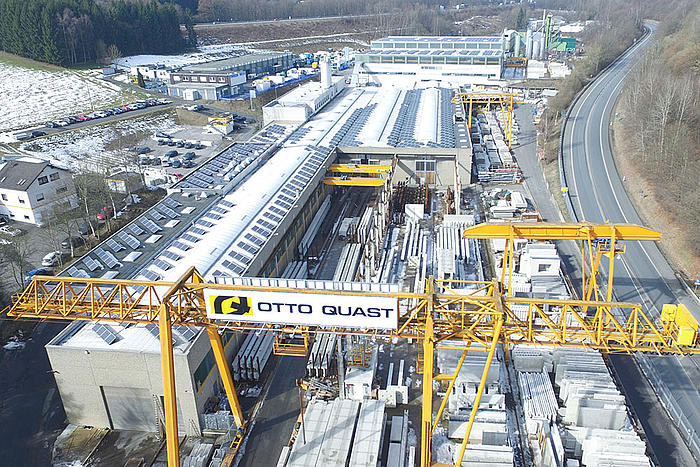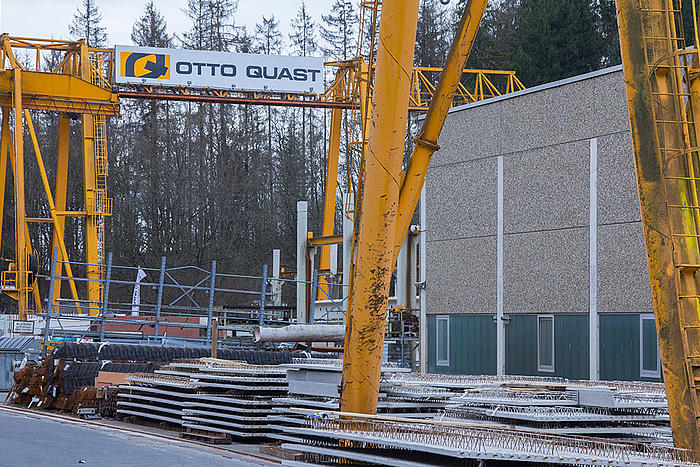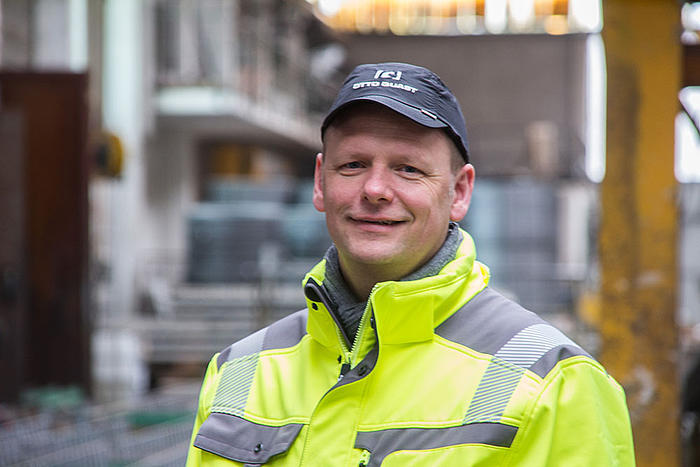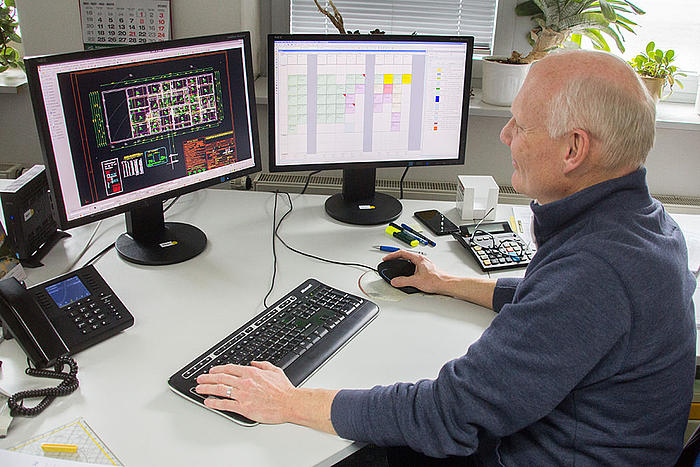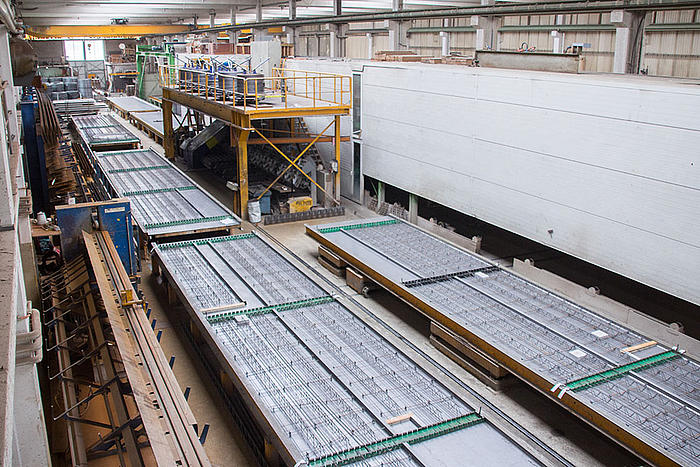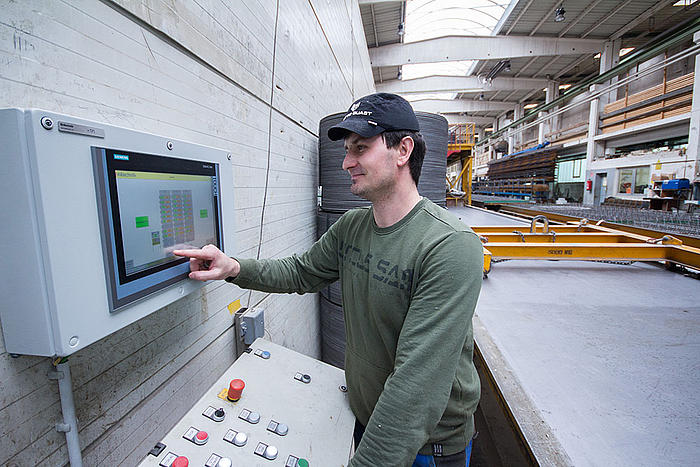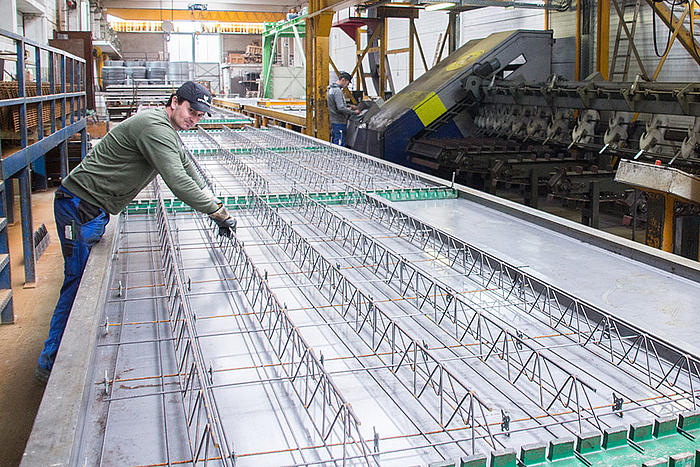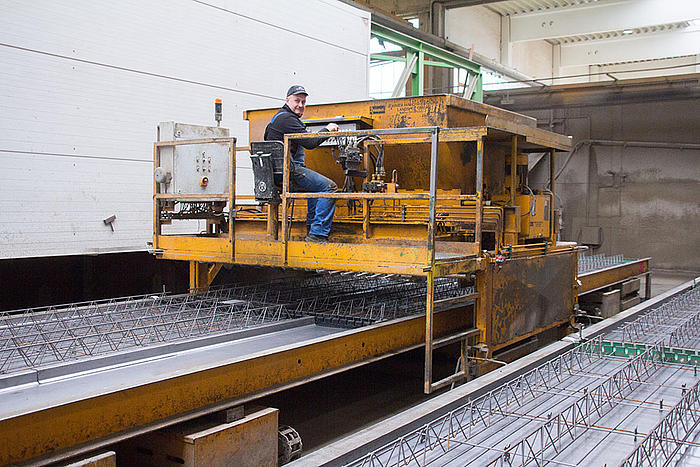The construction company Otto Quast is gradually modernizing its production facilities at the Freudenberg site: Part of the multi-year modernization and digitization strategy is the retrofit of the compact 25-year-old circulation system for the production of filigree ceilings. A wide range of technical possibilities is also offered by the next expansion stage, in which the ceiling system will be linked to the CAD and ERP systems by means of a master computer. Automatic pallet assignment, feedback of production data into the ERP and transparent processes are the intended results of the modernization.
Otto Quast, headquartered in Siegen (Germany), designs, constructs and renovates buildings, roads and bridges at all performance levels up to turnkey construction. The medium-sized company provides high-quality work in concrete, masonry, civil engineering and road construction from a single source. Likewise, production and administration facilities in industrial and commercial construction, designed by the company itself and executed as general contractor, are part of its daily business - and have been for 75 years. The group of companies also includes two precast concrete plants with locations in neighboring Freudenberg and in Coswig (Saxony). In addition to classic structural components such as columns, prestressed roof trusses and stairs, filigree slabs and wall elements are also produced on site. However, the entire product range covers much more: it includes underfloor containers, bridge elements and even foundations for electric chargers. The Freudenberg site sees itself as an engineering partner for its customers. The modern offices are home to 20 design engineers and construction planners who work together with customers to develop solutions tailored to their needs.
The production facilities have been adapted to the company's diverse range of products and services and have grown steadily over the years. The central areas that supply the entire plant include the reinforcement production, the carpentry shop and the mixing plant. Surrounding these areas are the product-specific manufacturing areas. A stationary production facility enables the production of the large structural elements. For example, columns up to 30 m long with footing, concrete elements weighing 57 tons, prestressed trusses and pi basins with a span of up to 37 m or individual stairs can be produced. Two circulation lines are used for the production of the flat elements. Solid parts and sandwich elements are produced on the newer of the two lines. A production line that is now more than 25 years old produces filigree slabs using the circulation process.
Otto Quast digitization strategy
The current retrofit measure on the slab plant is embedded in an overriding strategy. "With the help of modern technology, we want to secure the production of our plant, increase quality, raise productivity and thus ensure the competitiveness of our company in the long term," explains Andreas Schimanski, who is the managing director of the precast concrete plant.
The first measure was the modernization of the mixing plant by replacing the mixers and adding a silo. The next step was to switch to 3D CAD design in engineering. Strakon BIM CAD software from DICAD is used for the structural elements, and the bauBIT program is used in the ceiling department. BETSY is used for production planning. Now that the company is state-of-the-art on the planning side, the focus is now on the production facilities.
The slab plant before modernization
Hall 1 marks the start of the digitization offensive in production. Filigree slabs are produced on a compact circulation system. It was built in 1994 by the Sommer company. The rough production sequence is as follows. After cleaning, the pallet moves to the shuttering station. Here, formwork and built-in parts are placed. Two laser projection systems from Seifert assist in placing the parts. The pallet moves on to the reinforcement station by means of an enabling switch. A straightening/cutting system from Filzmoser provides the necessary round bars. At the next station, the lattice girders are placed and fixed before the pallet moves to the concreting station. By means of a manual concrete spreader, an employee places the appropriate amount of concrete. After compaction, the pallet moves into the curing chamber. Three pallets can be pushed one behind the other into one compartment. A special locking mechanism ensures that the rear pallets are transported to the front again when they are pulled out.
The plant's control technology has not been significantly changed since the plant was built. Until recently, a Simatic S5 control system from Siemens and the Interbus fieldbus from Phoenix with decentralized peripherals were in use. The drawings of the elements and the pallet assignment are printed out and run along with the pallet. The data for the laser projection are stored in a transfer directory on a virtual server. The arrangement of the elements on the pallets is currently still done manually. The assignment of pallet numbers and elements is managed in a manually maintained list.
Step 1: Modernization
As a basis for further measures, the control technology first had to be brought up to date. Contemporary IT systems can no longer be coupled with the outdated technology. But this is not the only reason for the renewal. "You can find fewer and fewer specialists who are familiar with the product family that was discontinued by the manufacturer Siemens many years ago. Not to mention the increasingly difficult supply of spare parts," reports Andreas Schimanski. "This has already had a noticeable impact on plant availability."
In the first step, a contemporary Simatic S7 replaces the previous control system. The Profibus system from Siemens replaces the Interbus fieldbus system. For the most part, the control cabinets and local control stations could be retained. Only the controllers and the decentralized peripherals were replaced. Thanks to good preparation, one week of downtime was sufficient for the Unitechnik team to convert the plant and put it into operation again. The most externally visible change is a large touch screen that now hangs on the wall of the curing chamber. The screen gives operators access to the plant layout and curing chamber occupancy. Retrieval orders can be initiated and rebookings made. True to the philosophy of digital transformation, the information comes to the employees - and where the employee needs it. No one should have to go to the control station to get information.
Step 2: Digitization
The next stage is already planned. At the beginning of next year, the slab plant will be linked to the CAD and ERP systems with a master computer. UniCAM.10 from Unitechnik will be used. This will enable Otto Quast to benefit from automatic pallet assignment, feedback of production data into the ERP system and a high level of transparency in production. Above all, however, the master computer opens up a multitude of digital possibilities. In the future, large screens will replace paper drawings and production key figures will be displayed for all to see in the hall.
Engage employees
Another aspect is very important to Andreas Schimanski: "Without our employees, the digital journey won't work: We have a great team and very experienced employees. They themselves have to be convinced of the benefits of the new technology. This works best if we involve you in the process."
This is also one of the reasons why Otto Quast decided to implement its digital agenda in several steps. "We have well-functioning processes. There is no reason to rush into the measures," adds Schimanski.
Conclusion and future prospects
Otto Quast is pushing ahead with a systematic modernization program for its precast concrete plant in Freudenberg. The retrofit of the filigree slab production is being carried out in two steps. After the renewal of the control technology, the UniCAM.10 master computer is now on the agenda. This enables the further digitalization of production - towards paperless production. "We have found a very good partner for the implementation of our digital agenda in Unitechnik," Andreas Schimanski sums up.
Even beyond the previous measures, there are further projects that will increase productivity in the future. Such as the partial automation of the reinforcement production, modernization of another circulation system.
Thus, within the next few years, various modernization measures will take place at Otto Quast to make the company market-dominant for the future.
